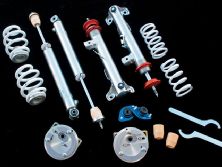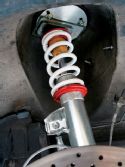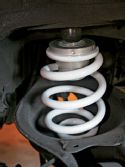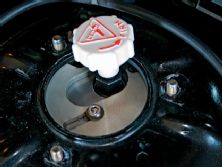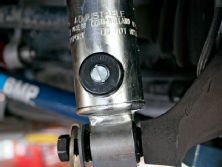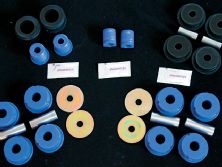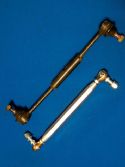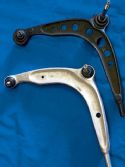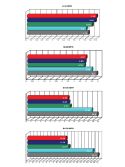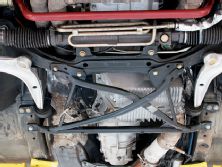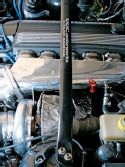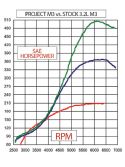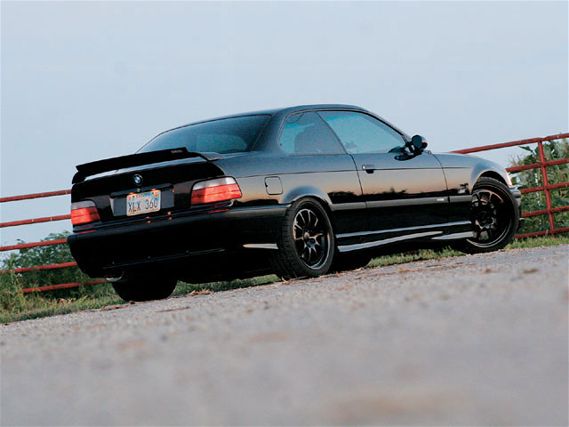 | BMW E36 M3 - Project Car
| BMW E36 M3 - Project Car
It's time to say goodbye to my most extensive project yet. I pushed the envelope in some areas and definitely learned from a few wrong turns. But that's all part of the experience. In the end, I can say this was a success, as anyone who's ridden in it can attest.
I tried tons of parts and finished with a track-worthy monster. All that was left was to make this car more enjoyable on the street, which would be done with suspension changes. The Advance Design setup worked well on the track, but required aggressive race tires to get the most from. With such stiff shocks, the car felt over-damped and under-sprung, way too stiff for everyday use. Had I considered turning Project E36 M3 into a track-only car I would probably have kept the system and swapped in stiffer springs, but I'm not taking that route. I called ICS Performance.
ICS is a fun group. Even if you're after a new set of springs, they somehow manage to get you thinking about 800-hp possibilities for your BMW. The firm now offers TC Kline suspensions to suit any 3 Series. I wanted something that would primarily be used on the street, so ordered its TC Kline Smart Design Double Adjustable coilover suspension system.
I opted for street-friendly spring rates-400 pounds up front, 500 pounds in the rear-which would maintain a mild understeer (only felt when pushing at the limit). The kit came complete, except for a set of instructions. Nevertheless, installation was fairly straightforward and the few questions were answered with a call to TC Kline.
The Smart DA setup features specially valved Koni shocks with racing internals. Ride height adjustment can vary up to two inches and can be changed in minutes with the supplied wrenches. The shocks are adjustable for both bump and rebound. Bump has three different settings for street or track. Rebound has 12 different settings for extra fine tuning.
The kit uses Vogtland VVS alloy springs. Thanks to a costly manufacturing process, the metals used are so strong that the wire can be made thinner without fatiguing. This allows the spring to have the desired rate but with more travel, which reduces coil bind. Additionally, all spring rates offered (varying between 300 and 650 pounds) are designed to have the same static length, which means different-rate springs can be used without having to adjust the ride height.
To make the most out of the new rear shocks, it was important to address the shock mounts. Those available through ICS are TC Kline monoball or Buna rubber units. I went with the latter and now there is no noise transference.
With a suspension install, an alignment is essential. Using the camber and caster plates, I set the caster at full for maximum high-speed stability. The camber was left at negative 1.5 degrees in the front with one degree in the rear. I can also dial in an extra two degrees negative camber if serious race rubber goes on. Toe was set to zero for the rear and 1/16-inch toe-out for the front, to improve turn-in response without increasing tire wear by much.
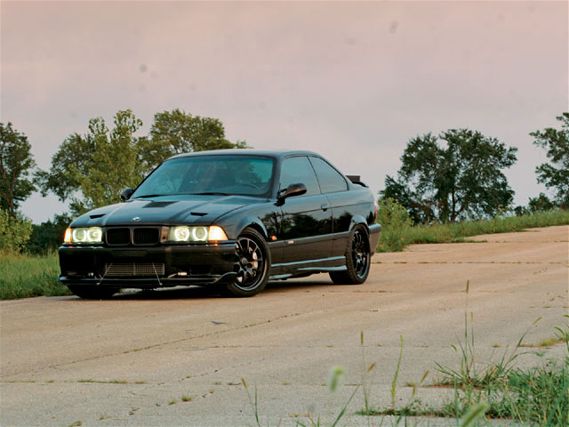 | BMW E36 M3 - Project Car
| BMW E36 M3 - Project Car
Speaking of tires, a suspension is only as good as the tires put with it. I chose Continental Conti Sport 2 V-Max to wrap the black forged Fikse Mach V wheels. With this much power and the recent Diffsonline 2.93 differential addition (ec, May '07), it's important to have the best tire possible, with plenty of headroom in the speed rating department. It's the only tire rated for 220 mph. With its asymmetric design, the idea behind the V-Max is not only substantial wet and dry grip but coping with the forces generated at high speeds. It does so with a super-strong structure and a groove pattern that features circumferential cooling grooves and lateral notches for maintaining cooler temperatures.
The car feels like a new model all over again. The TC Kline suspension really is the best of both street and track worlds. At its most forgiving setting, it rides almost as soft as a stock-suspended E36 M3. It's a nice setup for cruising around town or driving in the rain. Crank it down a little more and it still provides a smooth feel on the street, yet gives the confidence to throw the car around familiar turns. It helps the tires provide more grip than I'll ever need in the dry and plenty of grip in the wet. On the softest setting, I've logged a peak 0.95 g around a 270-degree turn at just 60 mph-without breaking sweat. And the stiffer settings leave plenty of room for greater performance with R-compound tires on track days.
Under hard braking with the 14-inch Brembo GT brakes, the tires grip extremely well and the ABS kicks in only if I get a little crazy with the pedal. Considering the braking forces and the horsepower, one would think front- and rear-end squat would be an issue, but it feels perfectly balanced overall.
When I started this project in 2000, the goal was 250 wheel-hp, achieved the following year with a Turner Motorsport cam kit, Evosport pulleys and a Supersprint engine-back exhaust system. In late 2001, I decided to turbocharge the car and the 400 wheel-hp target was with Active Autowerke's stage 2.5 kit, using a 60:1 compressor wheel boosting 15 psi, with some racing fuel in the mix.?
With Evosport's hard-wired installation and custom tuning of an AEM engine management system in 2004, the doors were opened for the current Speed Force Racing/Turbonetics T66 custom turbo system. With a 15-percent mix of 112-octane, the car was getting over 530 wheel-hp in third gear at 18 psi-the maximum load it would see on the dyno. On the street, the load would hold a steady 20 psi-which I would say is easily over 550 wheel-hp.
To call this a super 'street' car, I wanted a 500 wheel-hp pass in fourth gear, using nothing but 92-octane. After some time tuning the ignition maps with the assistance of Evosport's AEM guru, Gary Karamikian, I saw a detuned 506 hp with 440 lb-ft at the wheels in fourth gear (511 wheel-hp with 400 lb-ft in third) at 17 psi with just eight degrees of timing in the upper midrange that ramps up smoothly to a modest 11 degrees up top. Accomplishing this through a not-so-big P-trim turbine wheel in a 0.81 AR housing-plus 8.2:1 compression and stock 95 M3 cams-was very satisfying.
This happened in early 2007. Today, the car has a newly built T66 turbo with Turbonetics' F1-65 wheel-slightly larger and improved over the P-trim turbine wheel it replaces. Even with this larger exhaust wheel, I'm now able to see over 20 psi on pump fuel on a humid 90-degree Kansas day when adding 30 percent methanol to the AA/Aquamist water-injection mix. It's sweet, with zero knock activity. Sure, the new setup is a hair laggier than the smaller P-trim, but not by as much as I expected. The reduced midrange torque has helped gain some traction in the first-to-second shift, so I think it made the car quicker given the street tires.
Why no dyno with this new setup? That leads to the sad news. I've sold Project M3. The car will be back in Southern California by the time you read this. Excuse me while I wipe tears from the keyboard.
1. ICS Performance is a TC Kline dealer. TCK's Smart DA Suspension comes complete with specially valved Koni race-built dampers, Vogtland VVS springs, adjustable camber and caster plates, rear ride height adjusters, aluminum rear shock mounts and height adjusting wrenches.
2. Up front sit 400-pound springs.
3. The rear sports 500-pound springs to keep understeer in check. This setup is really nice on the street at the softest setting.
4. For track events with R-compound tires, start stiffening the Koni-built shocks with the supplied bump adjusters. If that uses too much of the outside of the tire, the camber can be adjusted by lifting the front of the car and loosening the three shock tower nuts.
5. You can also play with the rebound. A screwdriver will do the trick and it's 12 distinct clicks.
6. To renew the overall feel of the car, we also added Powerflex bushings from SPA Technique. Clockwise from top left: concentric front lower wishbone rear, rear anti-roll bar, rear trailing arm, rear beam mounting bushing front, rear beam mounting bushing rear.
7. With the SFR Turbo kit, the new intercooler piping gives plenty of room for the anti-roll bar link. Pictured on the right is the modified version Evosport made for us. Pictured left is the BMP Design adjustable link currently on the car.
8. VAC Motorsport offers genuine BMW forged aluminum control arms to reduce unsprung weight. These are the same units found in E30 M3s and are a direct replacement for the E36. Total weight saving is nine pounds.
9. As boost increases, off-line performance is compromised with wheel spin that doesn't go away until third gear. Past third (70-120 mph) acceleration becomes exponential.
10. Since the original BMW X-brace went missing at some point, we ordered another from Bimmerbum.com. At $125, it the best price we could find. Turn-in response is fully restored.
11. UUC Motorwerks sells a magnesium strut tower bar. At just two pounds, it stiffens the front shock towers and limits chassis flex, while not adding significant weight.
12. A comparison between a stock 3.2-liter M3 versus Project M3 on pump gas tuning, both tested on Imagine Auto's Mustang MD 500 dyno. Even with 8.2:1 compression, the car hangs in there down low. But as long as revs are kept above 4000, Vader M3 is in a different galaxy.

